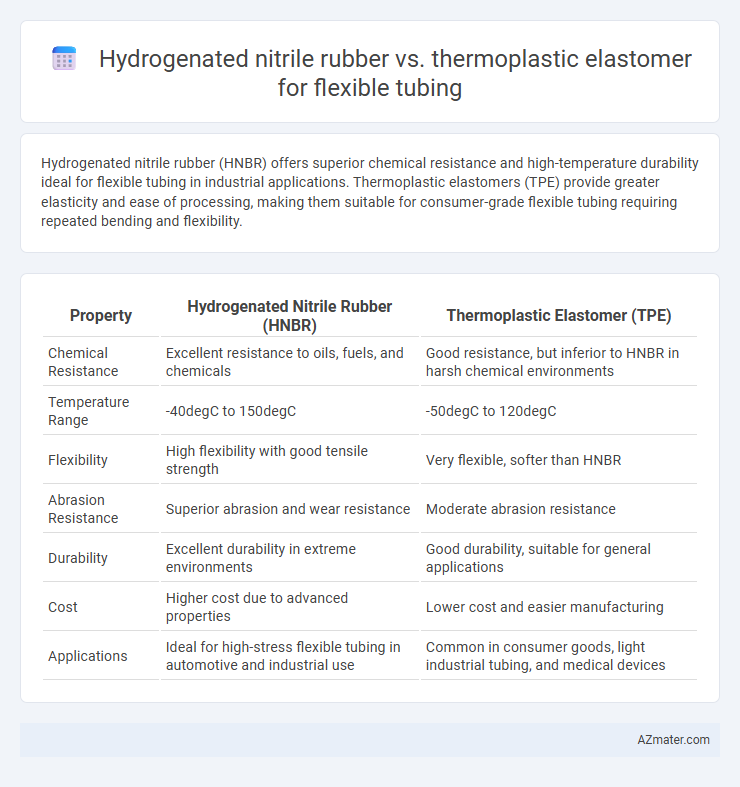Hydrogenated nitrile rubber (HNBR) offers superior chemical resistance and high-temperature durability ideal for flexible tubing in industrial applications. Thermoplastic elastomers (TPE) provide greater elasticity and ease of processing, making them suitable for consumer-grade flexible tubing requiring repeated bending and flexibility.
Table of Comparison
| Property | Hydrogenated Nitrile Rubber (HNBR) | Thermoplastic Elastomer (TPE) |
|---|---|---|
| Chemical Resistance | Excellent resistance to oils, fuels, and chemicals | Good resistance, but inferior to HNBR in harsh chemical environments |
| Temperature Range | -40degC to 150degC | -50degC to 120degC |
| Flexibility | High flexibility with good tensile strength | Very flexible, softer than HNBR |
| Abrasion Resistance | Superior abrasion and wear resistance | Moderate abrasion resistance |
| Durability | Excellent durability in extreme environments | Good durability, suitable for general applications |
| Cost | Higher cost due to advanced properties | Lower cost and easier manufacturing |
| Applications | Ideal for high-stress flexible tubing in automotive and industrial use | Common in consumer goods, light industrial tubing, and medical devices |
Introduction to Flexible Tubing Materials
Flexible tubing materials such as Hydrogenated Nitrile Rubber (HNBR) and Thermoplastic Elastomers (TPE) offer distinct advantages based on chemical resistance and mechanical properties. HNBR provides excellent resistance to oils, fuels, and high temperatures, making it ideal for demanding industrial applications requiring durability and flexibility. Thermoplastic elastomers offer superior processability and recyclability, combining rubber-like elasticity with thermoplastic advantages for lightweight, cost-effective tubing solutions.
Overview of Hydrogenated Nitrile Rubber (HNBR)
Hydrogenated Nitrile Rubber (HNBR) offers superior chemical resistance, heat stability up to 150degC, and excellent mechanical properties, making it ideal for demanding flexible tubing applications in automotive and industrial sectors. HNBR's resistance to oils, fuels, and abrasion ensures long service life compared to standard nitrile rubber. Unlike thermoplastic elastomers, HNBR provides enhanced thermal and chemical durability, essential for high-performance tubing exposed to harsh environments.
Overview of Thermoplastic Elastomer (TPE)
Thermoplastic Elastomer (TPE) offers excellent flexibility, chemical resistance, and ease of processing, making it ideal for flexible tubing applications. TPE materials combine the elasticity of rubber with the recyclability of plastics, providing durability and cost-effectiveness in industries such as automotive, medical, and consumer goods. Compared to Hydrogenated Nitrile Rubber (HNBR), TPE enables faster manufacturing cycles and improved customization in tubing design, while maintaining strong performance in temperature and abrasion resistance.
Mechanical Properties Comparison
Hydrogenated nitrile rubber (HNBR) offers superior abrasion resistance, tensile strength up to 40 MPa, and excellent resistance to oils and chemicals, making it ideal for demanding flexible tubing applications. Thermoplastic elastomers (TPE), while providing good flexibility and ease of processing, typically exhibit lower tensile strength around 15-25 MPa and reduced chemical resistance compared to HNBR. Mechanical properties such as hardness, elongation at break, and compression set generally favor HNBR for high-performance flexible tubing requiring durability and prolonged service life.
Chemical Resistance and Compatibility
Hydrogenated nitrile rubber (HNBR) offers superior chemical resistance compared to thermoplastic elastomers (TPE), particularly against oils, fuels, and aliphatic hydrocarbons, making it ideal for aggressive chemical environments in flexible tubing applications. TPE provides good general chemical compatibility but tends to degrade faster when exposed to strong acids, solvents, or high-temperature oils, limiting its use in harsh chemical settings. The enhanced saturation in HNBR's polymer backbone improves its resistance to oxidation and ozone, ensuring longer durability and reliability in chemically demanding flexible tubing systems.
Temperature Performance Range
Hydrogenated nitrile rubber (HNBR) exhibits superior temperature performance, maintaining flexibility and mechanical properties in a range from -40degC to 150degC, making it ideal for applications requiring resistance to heat, oils, and chemicals. Thermoplastic elastomers (TPE), while offering flexibility and easier processing, generally operate effectively between -50degC and 120degC but may degrade more quickly at elevated temperatures compared to HNBR. Selecting between HNBR and TPE for flexible tubing depends on the specific temperature demands of the application, with HNBR favored for higher temperature resilience and chemical stability.
Flexibility and Elastic Recovery
Hydrogenated nitrile rubber (HNBR) offers superior flexibility and excellent elastic recovery, making it ideal for flexible tubing subjected to dynamic stresses and extreme temperatures. Thermoplastic elastomers (TPEs) provide good flexibility but typically exhibit lower elastic recovery compared to HNBR, which can lead to permanent deformation under continuous flexing. The chemical resistance and durability of HNBR also contribute to maintaining tubing integrity, whereas TPEs excel in ease of processing and recyclability but may compromise long-term elasticity.
Manufacturing and Processing Methods
Hydrogenated nitrile rubber (HNBR) is manufactured through hydrogenation of nitrile butadiene rubber, offering enhanced chemical resistance and thermal stability, with processing methods including extrusion, injection molding, and compression molding. Thermoplastic elastomers (TPE) are produced via polymer blending or block copolymerization, enabling thermoplastic processing techniques like injection molding and extrusion, which allow easier recycling and faster cycle times. HNBR requires vulcanization for cross-linking and improved mechanical properties, while TPEs rely on physical cross-links and melt processability, making TPE more adaptable to automated manufacturing but less resistant to harsh chemicals and high temperatures compared to HNBR.
Cost Analysis and Sustainability
Hydrogenated nitrile rubber (HNBR) offers superior chemical resistance and durability but typically incurs higher production costs than thermoplastic elastomers (TPE) for flexible tubing applications. TPEs provide cost-effective manufacturing with easier recyclability, contributing to better sustainability profiles due to their thermoplastic nature and lower energy consumption during processing. Evaluating lifecycle costs reveals that while HNBR's longevity reduces replacement frequency, TPE's recyclability and lower initial investment present advantages for budget-conscious and eco-friendly tubing solutions.
Applications and Industry Use Cases
Hydrogenated nitrile rubber (HNBR) excels in automotive and oilfield applications due to its superior resistance to heat, oil, and chemicals, making it ideal for fuel lines, seals, and high-pressure hoses. Thermoplastic elastomers (TPE) offer versatile flexibility and ease of processing, widely used in medical devices, consumer goods, and food-grade tubing where repeated flexing and regulatory compliance are critical. Industries such as aerospace, petrochemical, and healthcare benefit from selecting HNBR or TPE based on required durability, chemical exposure, and manufacturing efficiency.

Infographic: Hydrogenated nitrile rubber vs Thermoplastic elastomer for Flexible tubing
 azmater.com
azmater.com